悠久的汉字
The Long History of Chinese Character
汉字,亦称“中国字”、“中⽂字”、“⽅块字”,是记录汉族语⾔的⼀种⽂字,属于表意⽂字的词素⾳节⽂字,得名于汉族和汉朝,是中华⽂明的重要标志之⼀。汉字是世界上使⽤⼈⼝最多、使⽤范围最⼴、使⽤时间最⻓的⽂字,其与古埃及象形⽂字圣书字、两河流域苏美尔⼈的楔
形⽂字⼀样属于世界上最古⽼的⽂字,也是⾄今唯⼀仍被使⽤的⽂字体系。
The Chinese character, also referred to as Hanzi, embodies the script and writing system utilized by the Han people. Its nomenclature originates from the Han Dynasty (206 B.C.–220 A.D.). Functioning as an ideographic and morpheme-syllabic system, it stands as a significant emblem of Chinese civilization. Furthermore, the Chinese character holds the distinction of being the most populous, extensively adopted, and enduring writing system globally. Unlike the ancient Egyptian hieroglyphics confined to sacred texts and the Sumerian cuneiform script originating in Mesopotamia, the Chinese character not only boasts antiquity but remains actively employed in contemporary contexts.
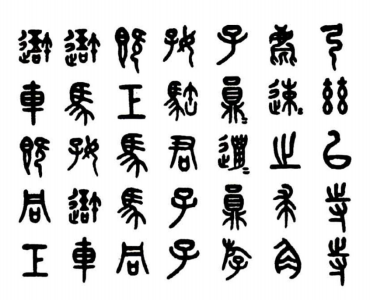
>汉字的起源
> The Origin of Chinese Character
考古学家在新⽯器时代后期的⼭东⼤汶⼝⽂化遗址(约前4500~前2500)发现了刻有符号的陶尊和残器⽚,这些符号被专家普遍认为具备简单⽂字的特征,是中国的原始⽂字。在仰韶⽂化(约前5000~前3000)早期的陕⻄半坡遗址中出⼟了⼤量彩陶,上⾯绘有⼈⾯、⻥、⿅、植物枝叶及⼏何形等纹样,其中⻥形纹被证实与早期象形字有很⼤关系。
During excavations at the Dawenkou Cultural sites dating back to the late Neolithic Age (approximately 4500 B.C.–2500 B.C.), archaeologists uncovered fragments of pottery vessels adorned with engraved symbols. These symbols, exhibiting characteristics akin to rudimentary script, are commonly perceived by scholars as ancient Chinese characters. Subsequently, at the Banpo Sites situated in
Shaanxi Province, numerous painted pottery artifacts originating from the early stages of the Yangshao Culture (circa 5000 B.C.–3000 B.C.) were unearthed. Among these discoveries are embellished depictions encompassing human facial features, fish, deer, plant branches and leaves, alongside geometric designs. Notably, the fish pattern has been substantiated to hold strong connections with early pictographic representations.

汉字产⽣之前,古⼈⽤结绳记事来记录⽇常⽣活,结绳即是将绳⼦打结,通过绳结的⼤⼩、数量来记录所发⽣的事情。刻⽊记事,也是原始记事⽅法之⼀。古⼈在⽵⼦、⽊头上刻上不同⼤⼩、不同样式的符号来记录⽇常⽣活。但是, 这种原始的记事⽅法,只能满⾜⼈们记录简单事件的要求,不能满⾜⼈们沟通、交流更多信息的需要, 于是先⺠开始探索另外⼀种交流信息的⼯具。随着⼈类社会的发展,结绳、刻⽊因为不能适应范围⼤、数量多的记事要求⽽遭到淘汰,渐渐地产⽣了图画⽂字、符号⽂字等原始汉字的维形。图画⽂字是由直观、形象、写实的图画演化⽽来, 通过多次的使⽤产⽣相应的联系, 具有某种约定性,从⽽在使⽤过程中达到消息互通的效果。由图画⽂字发展变化来的符号⽂字产⽣于公元前1万年左右,可以说是中国远古时代最初的⽂字。
Before the advent of Chinese characters, ancient practices involved the use of knots of varying sizes and quantities or the method of wood notching to document daily affairs. Typically, symbols of diverse sizes and styles were etched or notched onto bamboo or wooden surfaces. However, these ancient techniques primarily served to record straightforward events. As societal needs expanded for enhanced communication, ancient communities sought more effective means to exchange information. Consequently, as the exigencies of social progress surpassed the limitations of knot-tying and wood-notching, rudimentary pictographs and symbols emerged to fulfill these requirements, marking the early stages of Chinese character development.Pictographs evolved from visual and lifelike representations, their evolution fostered through repeated utilization, thereby enhancing practical communication. Originating approximately around 10,000 B.C., these symbols developed from pictographic writings and served as the precursors to the ancient Chinese characters.
>汉字的发展
> The Evolution of Chinese Character
公元前2000年开始,汉字开始进⼊字符积累阶段。汉字的发展演变过程,⼤致可分为甲⻣⽂、⾦⽂、篆书、⾪书、楷书等五个阶段。
Around 2000 B.C., the evolution of Chinese characters entered a stage of significant accumulation. This evolutionary process can be broadly categorized into five distinct stages: oracle bone script, bronze script, seal script, clerical script, and regular script.
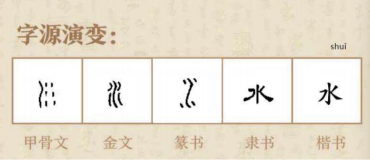
现存最早的汉字是殷商时期(前1600—前1046)的甲⻣⽂, 它是⼀套具有⽐较严密系统的⽂字体系,距今约有3000多年的历史,是由早期的表意符号发展演变⽽来的。“甲⻣⽂”的名称来源于商朝后期官廷内进⾏占⼘记事的⻳甲、兽⻣上的记⽂。在19世纪末,这些刻在⻳甲、兽⻣上的⽂字才被⼈们发现。由于甲⻣⽂是从图画⽂字演变⽽成的象形⽂字,商代早期的甲⻣⽂象形成分较多,直到商代晚期形声字的⽐例才逐渐增加。现在, 发现的甲⻣⽂有5000多字,其中1000多字已经能够被确切地辨认。甲⻣⽂的发现对于研究汉字的产⽣有重要意义。
The oracle bone script, originating during the Shang Dynasty (1600 B.C.–1046 B.C.), stands as the earliest form of Chinese characters in existence. This meticulous writing system, spanning over 3000 years, evolved from early ideographic symbols. As the name implies, the oracle bone script consists of characters inscribed on animal bones or turtle shells, predominantly utilized in the late Shang Dynasty's palace for divination or record-keeping purposes. Interestingly, its discovery only occurred towards the end of the 19th century. Initially, during the early Shang Dynasty, the oracle bone script bore a closer resemblance to pictographs, owing to its hieroglyphic origins rooted in pictographic writing. However, it wasn't until the later period of the Shang Dynasty that the proportion of phono-semantic compounds gradually increased within this script. Presently, more than 5000 oracle bone scripts have been unearthed, with around 1000 characters being distinctly identifiable. Overall, the unearthing of the oracle bone script holds immense significance in furthering our understanding of the genesis and evolution of Chinese characters.
在甲⻣⽂之后,⾦⽂逐渐产⽣。“⾦⽂”得名于后⼈是从⻘铜器上发现这⼀类型的⽂字的。商周时期盛⾏⻘铜器,以钟为代表的乐器和以鼎为代表的礼器的⻘铜器上常刻铸有⽂字,因此⾦⽂亦称“钟鼎⽂”。按照时间顺序,⾦⽂分为殷商⾦⽂、⻄周(前1046⼀前771) ⾦⽂、东周(前770⼀前256)⾦⽂和秦汉(前221—公元220)⾦⽂。最有代表性的是⻄周肘期的⻘铜器铭⽂,载字499个的⽑公鼎是其中最为典型的代表。⽑公鼎上的⾦⽂⻛格奇逸,结体⽅⻓,⽓象浑穆,笔意圆劲茂隽,历来被视为周代(前1046⼀前256)篆⽂的正宗
The progression from the oracle bone script led to the gradual emergence of the bronze script, a notable development during the Shang and Zhou Dynasties (1600B.C.–256 B.C.). Bronze artifacts such as bells and ritual implements like tripods commonly featured inscriptions, thus earning the designation "Script on Bell and Tripod." The evolution of bronze script is chronologically categorized into four distinct periods: the Shang Dynasty (1600 B.C.–1046 B.C.), Western Zhou Dynasty (1046 B.C.–771 B.C.), Eastern Zhou Dynasty (770 B.C.–256 B.C.), and subsequently, the Qin and Han Dynasties (221 B.C.–220 A.D.). Among these periods, the bronze script of the Western Zhou Dynasty stands out as particularly representative. An exemplary piece showcasing this style is the Maogong Tripod, adorned with 499 engraved characters. Characterized by its oblong structure, the bronze inscriptions of this period exhibit remarkable stylistic brilliance, emanating an unadulterated vigor and integrity. Consequently, the seal script of the Zhou Dynasty (1046 B.C.–256 B.C.) has long been regarded as a direct descendant of this distinctive style.
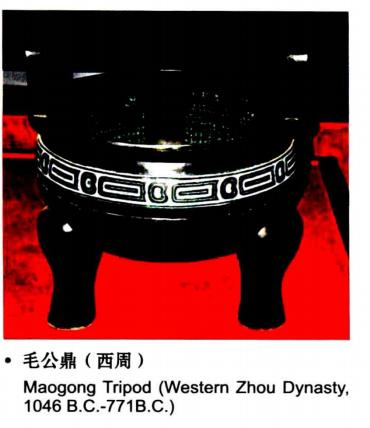
⼤篆是上承⾦⽂、下启⼩篆的过渡⽂字。战国时期(前475⼀前221)的秦国,通⾏起源于⻄周晚期的籀⽂,其字体与⼩篆相近,但字形的构形多重叠。除秦国之外的六国,即⻬国、楚国、燕国、韩国、赵国和魏国,则使⽤六国⽂字,⼜称“六国古⽂”。这⼀时期的⽯⿎⽂是⼤篆留传后世、保存⽐较完整且字数较多的书迹之⼀。⽯⿎⽂是刻于岩⽯上的⽯刻⽂字,因岩⽯形似⿎,故称“⽯⿎⽂”。⽯⿎⽂有中国“⽯刻之祖”的美誉,被奉为书家第⼀法则,具有很⾼的⽂史价值和艺术收藏价值。
The large seal script serves as an intermediary script positioned between the bronze script and the small seal script. During the Warring States Period (475 B.C.–221B.C.), the people of the State of Qin adopted the Zhouwen as their writing system. Originating from the late Western Zhou Dynasty, this script bears resemblance to the small seal script in style but exhibits overlapping structures. Concurrently, the remaining six states—Qi, Chu, Yan, Han, Zhao, and Wei—persisted in using their own linguistic forms, recognized as the Ancient Script of the Six States. An insight into the large seal script can be gleaned from the stone drum script of this era, preserved on drum-shaped stones from which its name derives. This script stands as the oldest known stone inscription in China and is revered as a foundational reference for calligraphers. Given its profound historical and artistic significance, the stone drum script holds considerable value and is highly esteemed for collection purposes.
秦始皇统⼀中国,创⽴了秦朝(前221⼀前206)。他推⾏的“书同⽂”政策,使得⽂字在⼤篆的基础上,进⼀步简化、整理,创造了⼩篆这⼀统⼀的汉字书写字体。⼩篆也称“秦篆”,成为秦代官⽅的通⽤⽂字。⼤篆到⼩篆的⽂字变⾰,在中国⽂字史上具有极重⼤的意义,标志着汉字向简明化、规范化的⽅向发展。
Following the unification of China and the establishment of the Qin Dynasty (221B.C.–206 B.C.) by Qin Shi Huang, the First Emperor of Qin, one of his pivotal initiatives involved the standardization of the Chinese script. As part of this endeavor, he simplified and organized the large seal script, resulting in the creation of the small seal script, also known as the Qin seal script. This small seal script was mandated as the official script across all the conquered regions, thereby establishing a unified communication system throughout China. This transformation from the large seal script to the small seal script holds immense significance in the development of Chinese characters, signifying a deliberate shift toward simplicity and uniformity in the Chinese writing system.
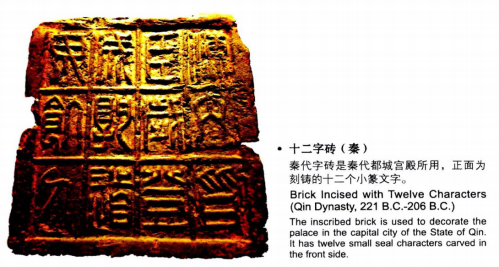
另外,秦代已产⽣了⾮官⽅的书写字体⾪书。⻄汉(前206⼀公元25)末年,⾪书逐渐取代了书写复杂的⼩篆,在全国通⽤。⾪书⽐⼩篆更加规范,书写更加简便。⾪书分为秦⾪和汉⾪。起源于战国时期,⽌于秦代的秦⾪,是汉字字形和书体演变的⼀个重要⾥程碑。汉⾪,是⻄汉使⽤最⼴泛的⾪书。⾪书是由古汉字向现代普遍使⽤的楷书过渡的字体,为汉字的成熟和稳定奠定了基础。⾪书被视为汉字第⼀个规范化的字体,⼩篆及其以前的书体被称为“古⽂字”,即篆书,包括⼤篆、⼩篆。⼤篆即甲⻣⽂、⾦⽂、籀⽂和六国⽂字,它们保存着古代⽂字象形的明显特点。⾪书及其之后的书体被称为“今⽂字”。前者更加淳朴、⾃然,后者则⽐前者更加成熟、系统。
The emergence of clerical script during the Qin Dynasty marked a significant shift. By the end of the Western Han Dynasty (206 B.C.–25 A.D.), its regular and simplified style gradually supplanted the intricate small seal script, becoming widely adopted. This script's development can be traced across two distinct periods: the proto-clerical script, originating in the Warring States Period (475 B.C.–221 B.C.) and further refined during the Qin Dynasty. This evolution stands as a pivotal milestone in the progression of Chinese character forms. As the Western Han Dynasty unfolded, clerical script became the prevailing choice. Positioned as a transitional script between ancient Chinese characters and the subsequently popular modern regular script, clerical script played a foundational role in the maturation of Chinese characters. Additionally, it signifies the initial step towards standardization. Previous scripts like the large seal script and small seal script belonged to ancient forms, encompassing oracle bone script, bronze script, Zhouwen, and Ancient Script of the Six States, retaining the pictographic essence of ancient characters. In contrast, the clerical script and its successors belong to the modern category. The former embodies natural simplicity, while the latter exudes a more mature and systematic appearance.
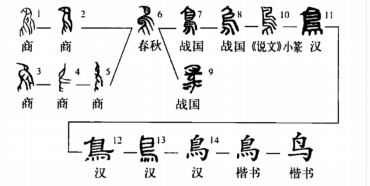
为了⽅便书写,在⾪书的基础上,出现了草书这⼀字体。草书, ⼜称“破草”,分为章草、今草狂草。初期的草书称为“章草”, 打破了⾪书⽅整、规矩、严谨的局⾯,是早期草书和汉⾪相融的雅化草体,在汉魏之际最为盛⾏,后⾄元代(1279—1368)⽅复兴, 蜕变于明代(1368—1644)。汉末,章草进⼀步“草化”,形成了今草,今草脱去了⾪书笔画⾏迹上下字之间笔势牵连相通,偏旁出现简化和互借,⾃魏晋
(220-420)后盛⾏不衰。到了唐代(618—907),草书的书写变得更加放纵,因⽽被称为“狂草”, 其笔势连绵环绕,字形奇变百出。但是由于⼀般⼈很难认出狂草,所以狂草也就失去了记载、传播信息的⽂字作⽤,⽽变成⼀种纯艺术性的、仅供欣赏的⽂字。
The cursive script, originating from the clerical script, emerged to streamline writing. Categorized into three groups—draft cursive, modern cursive, and wild cursive—the cursive script evolution began with the draft cursive, an early form that defied the strict rules of the regular clerical script. It elegantly fused the clerical style of the Western Han Dynasty with elements of early cursive. This script gained prominence during the Western Han Dynasty, Eastern Han Dynasty, and the revival in the Kingdom of Wei (206 B.C.–280 A.D.). Its usage persisted into the Yuan Dynasty (1279–1368) but underwent transformations during the Ming Dynasty (1368–1644). Subsequently, as the draft cursive became more informal by the end of the Eastern Han Dynasty, the modern cursive script emerged. This variant shed all connections to the clerical script, connecting subsequent characters in a single stroke, simplifying radicals, or sharing them with neighboring characters. Modern cursive gained popularity during the Kingdom of Wei Dynasty, Western Jin Dynasty, and Eastern Jin Dynasty (220–420). As the Tang Dynasty (618–907) approached, the cursive style evolved further, leading to the emergence of wild cursive. This extravagant style featured stretched and rotated handwriting, characterized by dynamic changes. However, due to its illegibility, people admired wild cursive primarily for its artistic value rather than using it for practical information recording or dissemination purposes.

魏晋南北期时期(220 589),汉字字体的发展较为错杂, 直到楷书的出现才结束这⼀局⾯。楷书,⼜称“真书”、“正楷”, 由⾪书逐渐演变⽽来,因其形体⽅正,可作楷模,故名。楷书的字形更加简化,将⾪书原有的扁平笔画变为⽅正,省去了汉⾪的波势。楷书逐渐取代⾪书,成为中国通⾏的正式字体。楷书的形成,标志着中国⽂字已经基本定型。三国时期(220-280)的钟繇(151-230) 是中国历史上的第⼀个楷书书法家。唐代是楷书发展的鼎盛时期, 颜直卿、欧阳询、柳公权等⼈的档书作品⾄今仍备受推崇。到了宋代(960-1279)、随着著字印刷术的发展,产⽣了宋体这⼀新型字体。
During the Three Kingdoms Period, Western Jin Dynasty, Eastern Jin Dynasty, and the subsequent Northern and Southern Dynasties (220-589), the writing styles of Chinese characters were notably intricate. This complexity persisted until the emergence of the regular script, also known as the 'true script' or 'standard script'. Derived from the clerical script, its nomenclature is attributed to its model-like square form, showcasing a much simpler structure. Diverging from the clerical style of the Western Han Dynasty, the regular script
displays strokes that are notably upright and straight, differing from the flat and wavy strokes of its predecessor. Gradually, the regular script supplanted the clerical script as the prevailing official script of China. Essentially, the formation of the regular script marked a crucial finalization in the development of Chinese characters.Zhong Yao (151-230), a luminary of the Three Kingdoms Period, stands as the first prominent calligrapher associated with the regular script in Chinese history. However, it was not until the Tang Dynasty that the regular script reached its zenith in development. Masterpieces crafted by renowned calligraphers such as Yan Zhenqing, Ouyang Xun, and Liu Gongquan continue to be highly esteemed to this day. As the Song Dynasty (960-1279) emerged, the development of movable type led to the creation of a new font—the Song typeface—marking a significant evolution in Chinese typographic styles.
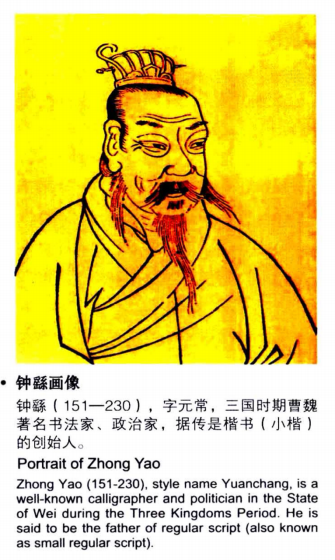
为了书写更加⽅便,汉字在原有的形体基础上,⼜演变出了⾏书。⾏书是楷书的变体,相传为东汉(25—220)刘德升所造。其形体不像楷书那样端正, 但是书写⽐楷书更加流畅、舒展。在汉末,⾏书未被普遍地应⽤,直⾄晋朝(265~420)⼤书法家王羲之书写时,才逐渐兴盛起来。现在,楷书、⾏书仍旧被⼴泛应⽤于汉字书写,
In order to simply writing, running script gradually evolves from the previous forms of Chinese characters. Running script is a variant of regular script and said to be created by Liu Desheng of the Eastern Han Dynasty (25-220). Unlike regular script, it is not upright in form but writes and extends more smoothly In the late Eastern Han Dynasty, running script was not in common use It is until the Western Jin Dynasty and Eastern Jin Dynasty (265-420) when the great calligrapher Wang Xizhi rose to fame, that the running script gradually flourished. Now, both the regular script and the running script are widely used in written Chinese?
汉字不仅仅是⼀种符号、⼀种⼯具,更是⼀本厚重的历史书,它记载着中国从古⾄今的⽂学、思想、⺠⽣、经济、⾃然等各个⽅⾯的内容。中国历代皆以汉字为主要官⽅⽂字,汉代时,被正式定名为“汉字”。不光在中国,⾮律宾、新加坡等国也有⼀定⽐例的⺠众使⽤汉字,运⽤汉语交流;中国的邻国⽇本、韩国,其⽂字⽇⽂、韩⽂都受到中国汉字的影响,在他们的⽇常⽣活中也仍然可以看到汉字。可⻅中国汉字在世界上的深厚影响。
The Chinese character transcends being a mere symbol or tool; it represents an extensive historical repository that chronicles multifaceted dimensions of society, encompassing literature, ideologies, societal norms, economic activities, and the natural world across various epochs. From its inception, the Chinese character has functioned as the principal official language, although its formal nomenclature did not arise until the Han Dynasty (206 B.C.–220 A.D.). Its influence is not confined solely to China; there are instances of its utilization in communication among populations in the Philippines and Singapore. Furthermore, the profound impact of Chinese characters extends to neighboring nations such as Japan and Korea, significantly shaping their linguistic systems. The ongoing presence of Chinese characters in their daily language usage attests to the enduring influence and importance of these characters beyond China's borders, exemplifying their pervasive impact on a global scale.
